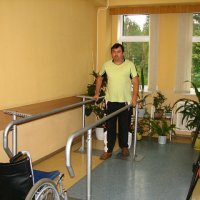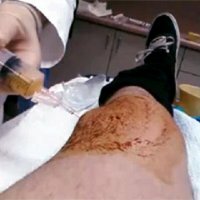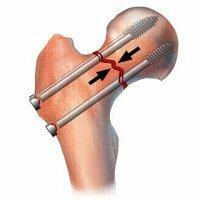Diagnosis - deforming gonarthrosis
Arthrosis diseases are a group of diseases affecting the joints, and cartilage tissues of the surfaces of the joints. The most common of these is deforming gonarthrosis, a disease affecting the knee joints. It was discovered more than 100 years ago, and in everyday life it is referred to as "salt deposition".
Deforming gonarthrosis.
In arthrosis, as a rule, soft joint tissues are calcified, that is, calcium salt is deposited at the attachment points of tendons, on the ligamentous apparatus, etc., but they have almost no clinical significance. And the main process, with deforming gonarthrosis, is a degenerative-dystrophic effect on the hyaline cartilage, which covers the condyles of two bones - femoral and tibia. Due to disrupted circulation of blood in small bone vessels, a pathological process begins, leading to changes in cartilaginous joints.
In the cartilage tissue, changes begin at the molecular level, which is the cause of gradual changes in the hyaline cartilage: it begins to grow duller, it becomes thinner, it breaks down and sometimes it gives cracks. As a result, the pathological process is completed by the fact that the cartilage completely disappears, leading to the exposure of the underlying articular bone. On the bone, as a reaction to the disappearance of cartilage, there are condensations of subchondral zones, so-called sclerosis, and the bone can expand around the periphery, there are so-called "thorns", which leads to deformation of the bone itself and curvature of the leg along the axis. That's why the full name of the disease appeared - deforming gonarthrosis.
Diagnosis - deforming gonarthrosis is divided into two forms:
- primary
- secondary.
Primary gonarthrosis affects elderly people, women fall ill with them more often, men. To the appearance of gonarthrosis are people with obesity, excessive body weight.
At the heart of secondary gonarthrosis is a knee injury or a previous illness, like arthritis, joint chondromatosis and the so-called "articular mouse."
Timely high-grade treatment of the above processes will help to prevent the emergence and development of gonarthrosis. Symptoms of gonarthrosis are a feeling of stiffness in the joint, like, "pulling" under the knee, and frequent pain after long walks.
The patient also has difficulty walking, after sleeping, especially in the morning, or after a long rest. Without the necessary treatment, the disease progresses, the pain intensifies, becomes permanent, and appears more often;The inner side of the knee most often hurts. Often when you move, you feel a crunch in your knee joint. Gradually the possibilities of flexion and extension are limited. The diagnosis of gonarthrosis may eventually cause progressive lameness. In especially difficult cases, patients completely lose the ability to move without support on anything, without crutches or without assistance. The pain is extinguished in the supine position, but occasionally the patients are overtaken by attacks of pain at night.
In the initial stage, when examining the knee joints, external changes are difficult to detect. But later the deformation of the knee becomes more distinct, the rough contours of the bones become more noticeable, and the possibility of full bending or extension disappears. Feeling the palm of the front of the knee, with flexion and extensor movements, one can feel a crunch in the joint.
After palpation of the joint, it is possible to identify painful areas, which are most often found on the inside. Also, often there is a flattening of the contours of the joint due to bulging, this is due to the attachment of synovitis to the cavity of the knee joint, that is, the accumulation of effusion. The synovitis of the knee joint indicates complications of gonarthrosis with aseptic inflammation, a condition called arthrosis-arthritis.
Establish a diagnosis of deforming arthrosis is not difficult, using the clinical diagnostic methods that are indicated above. But not all examined patients have symptoms of gonarthrosis, since age changes of joints can not be equated with arthrosis. Therefore, in any case, to confirm the diagnosis and determine the degree of arthrosis changes, it is necessary to conduct an x-ray study. Also, X-ray studies provide an opportunity to monitor the dynamics of the disease.
Treatment of the disease.
Treatment of gonarthrosis is a very difficult task, takes a very long time, and has two types, conservative and operative. At the heart of the conservative method of treatment lie rest and elimination of the load on the affected knee joint. If these conditions are not met, treatment will be ineffective. In a hospital, cuff hood is often used for the shin to achieve complete unloading of the knee joint.
First of all, the patient is prescribed non-steroidal anti-inflammatory drugs to relieve the patient of inflammation and pain, since pain is the main reason for going to the doctor. In a phase where gonarthrosis is complicated by a synovitis, in order to relieve the pain and inflammation, intra-articular corticosteroids are used.
To support the functional functions of the joint, chondromodulatory therapy is used. Medicines glucosamine and chondroitin sulfate, called chondroprotectors, are used intramuscularly, intraarticularly and for oral administration, in the form of food additives.
In combination therapy for gonarthrosis, therapeutic gymnastics plays an important role. It is carried out for the prevention of contractures. But in addition, it improves blood circulation in the limbs and serves as a basis for increasing muscle tone. The first exercises should be done in the morning, before you get up on your feet. The complex of exercises is obtained in the room of physiotherapy exercises, and is conducted about 4 times a day. After classes, a recumbent rest is recommended for just over half an hour. The complex of exercises is completed with alcohol compresses and warm baths. Punctuality of their accomplishments is very important.
Also the treatment is supplemented by different kinds of physiotherapy, such as Novocain electrophoresis, diadynamic current, ultraviolet irradiation, phonophoresis with hydrocortisone, magnetotherapy, laser therapy and foot massage.



